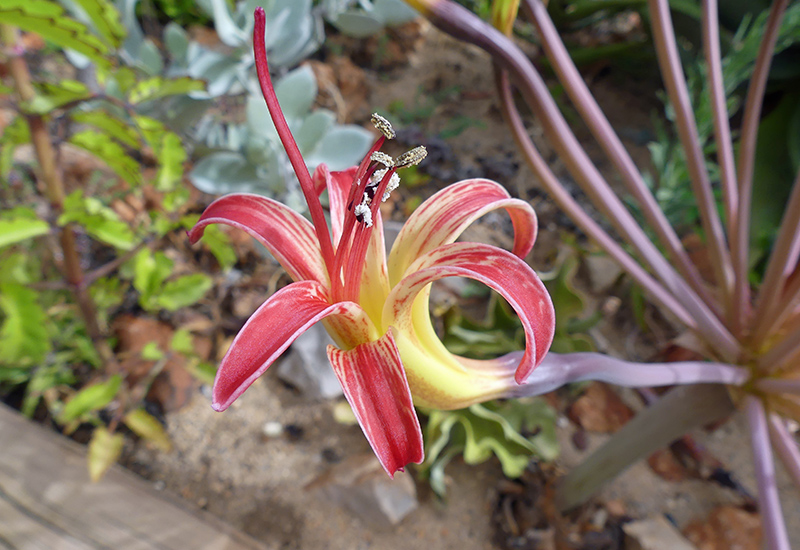The Surprising World of the Amaryllis Family
WORDS Tamsin Varley
Seven years ago, on holiday in the south of France, I spotted some magnificent flowers in a botanical garden. A long stalk emerged from a large bulb with thirty or so tubular red flowers, each on a long stem resembling an exploding firework. The label said Brunsvigia josephinae and I resolved to track one down as soon as possible.
I duly found one on the internet but was very disappointed to receive a tiny bulb, as these plants will not flower until the bulb is very large. I eventually planted it in a raised bed with some succulents where, for a few months of the year, I was treated to an impressive display of large strap leaves. However, this year, in September, after seven years of waiting, my bulb finally flowered. You can imagine my excitement as my patience was finally rewarded.
You may not have heard of this fantastic bulb, but it is the largest in the Amaryllis family. The name Amaryllis is a Greek word meaning ‘fresh’ or ‘sparkling’, which describes the opulence and exuberance of the flowers perfectly. They tend to be mainly bulbous flowering plants that are found in tropical and subtropical regions, and include many ornamental garden plants and vegetables. There are three main subfamilies including Agapanthus, Alliums and Amaryllis.

Brunsvigia flower

Alliums

Amaryllis belladonna
Agapanthus, or Lily of the Nile, derives its name from the Greek Agape, ‘love’ and Anthos ‘flower’ and they are native to southern Africa. Strap-like leathery leaves come from fleshy rhizomes and in summer, umbels of blue to white tubular flowers are produced on long stems. They like to be grown in well-drained soil in a sheltered spot with full sun. As they like their roots to be constricted, they make great pot plants.
We are all familiar with the Allium sub-family, which includes vegetables and herbs such as garlic, onions, leeks, shallots and chives. They are characterised by a distinctive sulphurous aroma which becomes more obvious when the bulbs or leaves are crushed. There are also ornamental Alliums which flower in spring and have spherical heads of flowers in shades of purple and pink to white. They like moist, well-drained soil in full sun. I have tried growing them in the Algarve in the ground, but after a year or two, the bulbs wither away, so they might be best planted in pots.

Butterfly Amaryllis

Hippeastrum
The Amaryllis sub-family includes many ornamental bulbs such as the spring flowering snowdrops, daffodils, Clivia, and Hippeastrum which look spectacular in winter and autumn flowering Nerine and Amaryllis belladonna or Jersey lily. One of my favourites is the kaffir lily or Clivia miniata which is native to woodlands in South Africa and Eswatini. It needs dappled light, as found under the shade of trees, and must have a free-draining growing medium with plenty of organic matter as it is prone to root rot. Once established, it is very drought tolerant.
Another plant I love is Amaryllis belladonna, which prefers full sun and well-drained soil. They self-seed readily so you can be assured of many volunteers. I associate Hippeastrum, more commonly known as Amaryllis, with Christmas because as a child we often received them as presents and enjoyed planting them up and seeing them flower some eight weeks later. They are very easy to grow and are a fun way of introducing children to the delights of gardening.

Agapanthus

Clivia
Tamsin Varley is a member of Clube Dos Bons Jardins, a small, friendly multi-national garden club that meets at different locations around the Algarve on the 2nd Tuesday of every month with an optional lunch afterwards.













